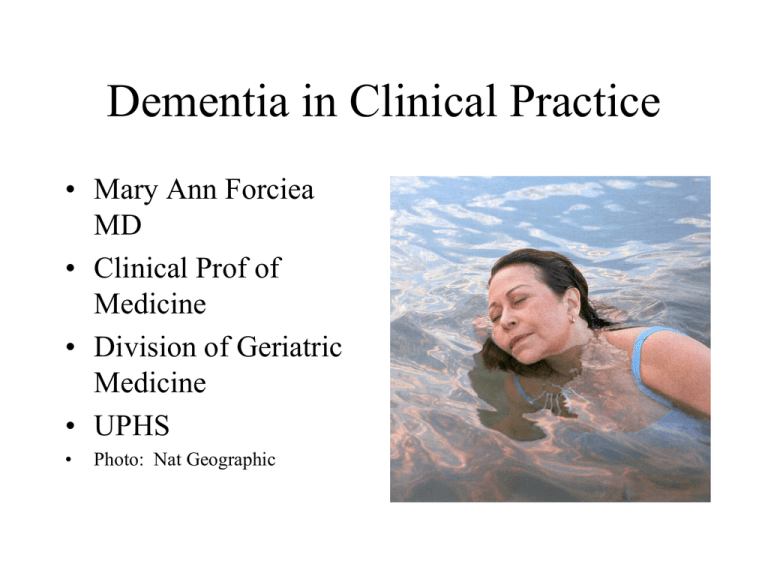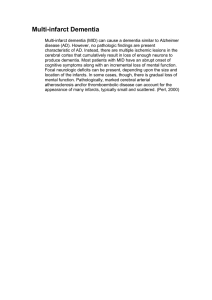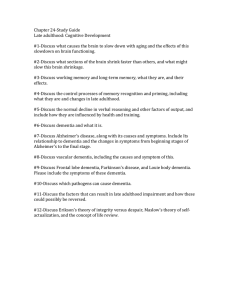Dementia in Clinical Practice • Mary Ann Forciea MD • Clinical Prof of
advertisement

Dementia in Clinical Practice • Mary Ann Forciea MD • Clinical Prof of Medicine • Division of Geriatric Medicine • UPHS • Photo: Nat Geographic Who has dementia? • 78 yr old retired librarian • Lives alone, children visit on holidays • Family concerned about ‘clutter’ in house, hygiene, unpaid bills • 68 yr old child care worker • Lives with her husband, drives, in charge of ‘house money’ • “Forgot” a child in classroom at end of day Who has dementia (2) ? • 84 yr old urology inpatient • 70 yr old homebound patient – Post op day 1: hostile – Bedbound, mute – Family caregivers – Oral intake decreasing • Attempts to strike nurse with cane • Refusing blood draw • Pulled out catheter Terms • Dementia – Chronic, progressive – Impairment in >1 domain of cognition • Mild cognitive impairment – Impairment in 1 domain of cognition – ? “pre-dementia” • Delirium – Short term What do we know about Brain Function? • Cell structure – Microscope (biopsy, cell culture) – PET scans • Brain regions – imaging • “Domains” of cognition – Imaging – Psychological testing Cell structure: Neurons • Networks • Grey matter/white matter Brain regions • Regions have different activities Domains of cognition • • • • • • Memory Calculation Language Orientation Spatial construction Executive function (judgment) Mapping Memories Natl Geographic What is wrong in dementia? Theories Neurons: waste products, shape of cells, signaling, genetic flaws Regions: biochemistry, structure Domains: communication We don’t yet know. Clinical observations • All patients with dementias are not alike. – – – – – – Age of onset Family history Initial symptom Most troublesome symptom Rate of progression Response to treatment • Is dementia a symptom, not a disease? Dementia Subtypes • Alzheimer’s Disease • Fronto-temporal dementia (formerly Pick’s Disease) – 15% • Corticobasilar dementias • Dementia with Lewy Bodies – 20% – Distinguished from Parkinson’s Disease with dementia • Vascular disease Alzheimer’s type dementia • Gradual onset • Global impairment in cognition – Usually memory impairment predominant • Increased risk in siblings – Apo e allele risk • Slow progression (5-7 years) – Predictable course (global deterioration scores) AD - pathology • Imaging • Neuropathology – quantity and location – Senile plaques • White matter • Amyloid core – Neurofibrillary tangles • Tau protein abnormalities – Initial concentrations highest in hippocampus and temporal lobes What clinical problems do patients with Alzheimer’s Dementia Encounter? • Diagnosis • Symptom Management • End of life care Case 1 NC • 64 yr old retired OR nurse • Referred for evaluation of impaired memory – Birthdates, telephone numbers – Impaired job performance for 1-2 yrs prior – Inability to ‘balance checkbook’ • Gradual decline over 5 years • Died of pneumonia Diagnosis • • • • Largely on history Exclude other conditions Role for imaging in near future Staging – Mental status testing (MMSE, MOCA, MiniCog) – Functional status staging (FAST, GDR) FAST • • • • • • • • The FAST scale has seven stages: 1 which is normal adult 2 which is normal older adult 3 which is early dementia 4 which is mild dementia 5 which is moderate dementia 6 which is moderately severe dementia 7 which is severe dementia AD - treatment • Improve all co-existing conditions! • Specific treatments – Cholinesterase inhibitors • Donepazil, rivastigmine – Adrenergic stimulants • Memantine • Treatment of associated symptoms – Agitated behaviors • Non pharmacologic, environmental • drugs End of life issues • Should be anticipated – Advance Directives, conversations with proxies • Goals of care – – – – Nutrition Hospitalization Caregiver burdens Hospice involvement Summary • “Dementia” is a symptom complex • We are in the early stages of understanding the pathology, and discovering effective treatment • Optimal care requires advance planning, caregiver involvement, and a team of professionals






